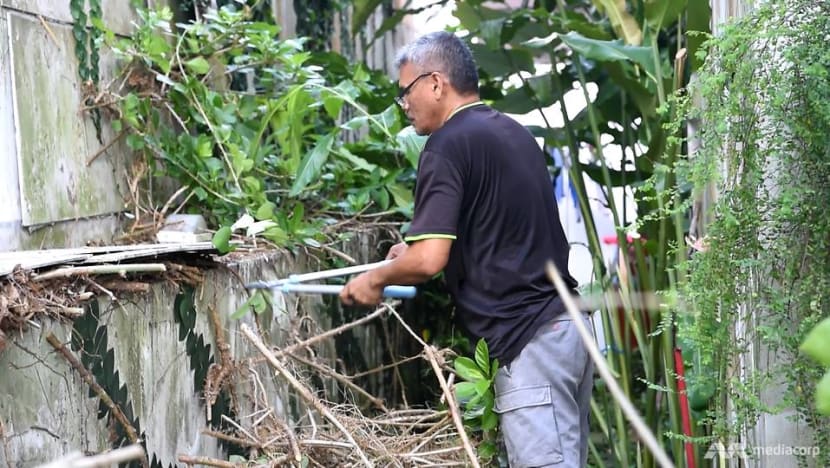‘You’re paying for my experience, not my labour’: The handyman trying to earn his keep
If there’s something wrong with your home fixtures, who are you going to call? Benjamin Arman, for one, isn’t afraid of choked toilets, but what his services are worth to some customers is another matter altogether.

He calls himself a jack of all trades, from electrical to plumbing to miscellaneous repairs.
SINGAPORE: I must admit that things had needed repairing in my toilets since last year. Two metal hoses and a shower hose would leak when in use.
However, this had yet to figure on my list of priorities — which means my wife had not yet threatened to strangle me with the hoses for not fixing them.
But when my colleague Chiew Tong started working on her feature video about handyman Benjamin Arman, I jumped at the opportunity to employ his services. It was convenience I was paying for when he replaced my leaky hoses.
Of course there are others who would not part with S$60, not counting the cost of the new hoses, to get a handyman to do that.

He knows that all too well. Some “cheapskate” customers had bigger problems but wanted to pay less — like a condominium resident who baulked at paying him even S$50 to unclog a toilet.
“You can’t ask me (to charge) S$20 if I have to clear (a choked toilet) with the shit there,” said Ben.
“They like to bargain. If … it takes me five minutes, then I charge you S$100, you’d say, ‘Why expensive?’ If you get somebody on the street ... he’d say he can do it, but he’d take more than one hour.
“I’d say you’re paying me for my experience, not my labour.”

In modern Singapore — digital city state, the world’s most competitive economy and mostly white-collared — many who do not have the time or experience to fix problems around the house would have to pay those who do.
Ben calls himself a jack of all trades, from electrical to plumbing to miscellaneous repairs. But there is that question whether a handyman like him is appreciated enough for his time and skills and, by extension, earning a fair wage..
ON THE JOB
To viewer Linda Leung, commenting on CNA Insider’s video post, S$50 is a reasonable fee for unclogging a toilet: “For the transport fare and his expertise. Moreover, he has to come with his tools and all. It’s a hard job.”
Watch: The Singaporean handyman and his Malaysian family (7:23)
It can be tiring, Ben himself said, “to travel from one place to another”. “There’s a lot of walking,” the 55-year-old added as he picked up his tattered backpack. And during Ramadan recently, he had to be careful to “conserve energy”.
He takes public transport on the job, except when it is urgent, in which case he would book a taxi. Resting on his shoulders wherever he goes is about 20 kilogrammes worth of tools and spare parts.
And he goes to a range of properties, from public flats to condominiums. When CNA Insider shadowed him for a day, his first customer was condo resident Nicole Capatana, 35.
She had called him to fix a cabinet handle and door hinge as well as hang several paintings on the wall. And he was quick to diagnose the problem that needed the most repairs: The cabinet hinge.

“Looks like a hole is worn out,” he remarked. As he did not have the exact replacement screw, he improvised by drilling a deeper hole so that the new, longer nail will have grip.
Such jobs are not difficult, he said, but people need his service “because they don’t know what the problem is”. Within an hour, he also fixed the cabinet handle and hung five paintings on the wall, for S$70 in total.
The result was a happy customer. “I don’t have time, or I don’t know how to fix them … so a specialist should come,” said the Romanian expatriate, who acquired Ben’s services via an app.
“It’s good value for money, and also the fact that … I can find someone who can fix my problem fast is quite great.”

For the self-confessed “talkative” handyman, the favourite part of his job is meeting people like her.
“Sometimes when you do a job, you get bored … When you talk, it makes it interesting. And we try to develop that customer service relationship and trust, so next time, (when they’ve) got something, they’d call us back,” he said.
He does not accept all jobs, however, recognising that his versatility goes only so far. “If the problem is very deep, then I’d call, let’s say, the licensed electrician to (fix) it,” he said.
One of his considerations is the duration of the rectification. “Second is when the cost is going to be more like S$300 … then I recommend they get a contractor.”

A YOUNG MISTER FIXIT
He first picked up the skills and tools for fixing things when he was young and living in a kampung.
“There were a lot of things at home (to fix). My mother was always calling, ‘Ben, something’s wrong with my cooker, something about the plug. Can you change the light bulb?’” he recounted.
“So I always (fixed) things. And I was always curious about how things worked … I liked mechanical things, technical stuff … When it puzzled me, then I’d go into it, learn about it.”

But he never expected that what he did as a “sideline” would become a full-time job, as it did not use to be a well-paid one.
He became a handyman only in 2016, when he saw an advertisement for a job said to pay about S$40 an hour for doing repairs.
“That was the job I applied for, and then I found out it’s not a job, actually. It’s an app,” he said, referring to start-up Sendhelper’s mobile platform, which offers handyman, cleaning and cooking services.
This is not the only home services app he uses now, and the technology makes it easier not only for customers to get the help they need but also for handymen to get jobs, at least “about three or four” a day.

“It depends on how much you can do,” he said, contrasting it with the way handymen sometimes needed to approach plumbing shops, electrical shops and contractors previously to get enough work.
“You were lucky if they called you … because sometimes those shops also had their own favourite handyman.”
As to whether people look down on the job, he replied that it depends on the individual, though he clearly thinks “they should appreciate” having others do a job for them.
What he appreciates is the freedom to plan his schedule and choose his jobs, depending on the travelling time and job difficulty, among other things.

For example, he notices that there are more painting jobs before Hari Raya Aidilfitri, but tends to avoid them. “When you paint one room, you have to wait at least about half an hour (for it) to dry,” he noted.
“Then you have to apply the second coat and wait for another half an hour. And then you do the final touch-up, so it’s likely to take you, for one room, at least four hours.”
For each job he takes, his base fee is S$40 for labour, with additional charges largely dependent on the difficulty and materials needed. He now earns between S$3,000 and S$4,000 a month, at least thrice what he used to earn.
THE TOUGH TIMES
Before he became a handyman, Ben was doing odd jobs with various companies for about 15 years. He had difficulty finding full-time employment since the recession in 2001.

“The pay was really low … I didn’t mind working long hours, but they’d say you aren’t qualified for the job,” said the O-level holder. “They believed older people gave more problems than the younger ones, especially with medical (costs).
I had my first child in the year that was the recession, so it was a bit tough. But we managed.
One of the openings he found was for a range warden to maintain a shooting range for the army. He went on to work in different ranges and companies until 2005.
Another job he did on a temporary contract was as a packer on a fish farm. It was a four-hour, $S50 working day and unpredictable in terms of frequency. It lasted for only a few months.
He also worked part-time to load and unload cargo for FedEx. “I just took any job that was suitable,” he said. “If I could bring back S$1,000, I was okay with it.”
It was thanks to his experience from his first job after National Service — with the National Parks Board — that he managed to meet his income target to feed his family of five.
He was making a bit of money on the side by doing landscape maintenance at several houses. And if there was one job he especially liked, this was it.

In 2013, he did a Workforce Skills Qualifications landscaping course because he figured that paper qualifications would do the trick in Singapore.
“I had that experience in landscaping, but I didn’t have the paper, so that’s why I took the course,” he explained.
He also did a course on food handling and worked as an assistant in a food centre for a year. All these, and his Malaysian wife’s dressmaking activities, helped to pull the family through those years.
“My kids didn’t demand much because they knew their father’s capability … (and) what we could afford,” he said. “We always taught (them) about sharing and … (not to have) high expectations.”

It helped that they were living in a kampung home in Johor Bahru — and still do. So the exchange rate has worked in their favour.
FROM ONE GENERATION TO THE NEXT
Ben now travels back to Johor Bahru every week to spend the weekend with his wife and three daughters, aged 14, 16 and 18.
He thinks of them especially when he is having dinner alone in his one-room flat, “because when I’m in JB, I always have dinner with them”. Said the Singaporean: “It makes me look forward to seeing them over the weekend.”

His home in Chai Chee is also his workshop, which he spent almost two years building up as he accumulated the tools of the trade.
And on occasions when his daughters stay over instead, he gets to acquaint them with his work.
“At primary school, they didn’t know what I was doing. They always asked my wife what Daddy’s job was because … I swapped a lot of jobs,” he recalled. “Now (with) my permanent job, at least they know.”
The middle child, Dalila Nur Zhakirah, has even helped him out on some assignments. Just as he did all those years ago, she has been learning from him to fix things around their kampung home out of curiosity.

Her first repairs? Replacing one of their toilet seat covers, which was broken.
She told CNA Insider: “I think everyone has to know how to do a handyman’s job because in a situation where you’re alone and you don't have the money to pay someone to fix this, you’d have the basic (know-how).”
Her father acknowledges, however, that the younger generation might not see the relevance of the profession, or even the value of fixing things, because “stuff is cheap now”.
“Repairing (something) doesn’t guarantee it’ll be okay,” he said. “Items last time could last you for years, compared to now.”

He also thinks the younger generation may not be keen on the profession because “they don’t see the money” in it. “Some might pick up (the skills), like me when I was young, (but not follow through),” he said.
“They don’t see the bigger picture. In the end, you gain experience … get the recommendations and you get regular customers. And you’d get self-recognition.”
While the job can get “dirty and smelly”, for example when toilets are choked, that is why he charges more, he pointed out. There are also qualifications available, such as the Basic Handyman and Repair course provided through SkillsFuture@PA.
Ben himself has done electrician and plumbing courses, and he encouraged young people to give handyman work a go at home. “(If) you never try, you’d never know,” he said. “Probably you’ll like it.”


















